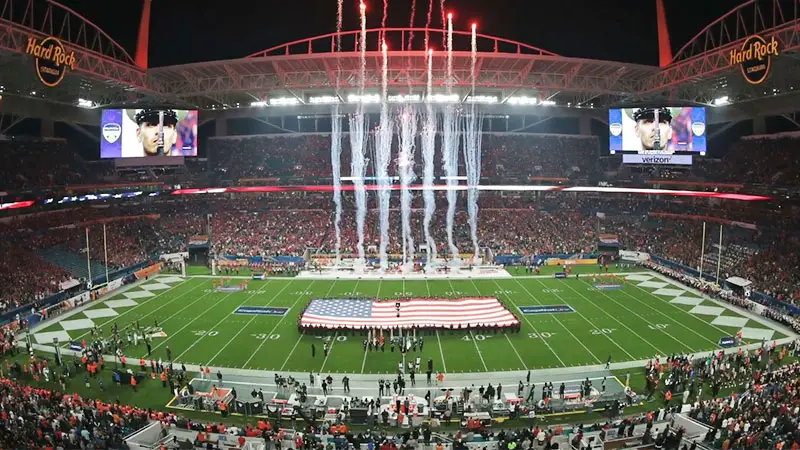Ever wondered just how long an NFL football field is? Whether you’re a die-hard fan or a curious newcomer, understanding the dimensions of the field can deepen your appreciation for the game.
An NFL field measures a whopping 120 yards in length, which includes two 10-yard end zones at each end. This uniform size is consistent across high school, college, and professional levels.
But it’s not just the length that’s standardized. The width of the field is 53 1/3 yards, providing ample space for those thrilling plays and strategic maneuvers. In total, the field covers 57,600 square feet or about 1.32 acres.
Knowing these dimensions not only helps you grasp the scale of the game but also enhances your viewing experience, letting you better appreciate the athleticism and strategy involved.
NFL Football Field Dimensions Overview
An NFL football field’s length and width play a crucial role in the dynamics and strategies of the game. Understanding these measurements provides deeper insight into the sport.
Length and Width of the Playing Field
The NFL football field measures 120 yards in total length. This includes two 10-yard end zones at each end. The main field of play covers 100 yards. The width of the field is 53 1/3 yards, equating to approximately 160 feet.
These dimensions create a playing surface totaling 57,600 square feet, or roughly 1.32 acres.
Significance of the End Zones
End zones are essential to scoring in football. Each end zone extends 10 yards from the goal line to the end line and spans the width of the field. A touchdown, worth six points, occurs when the ball crosses the plane of the opponent’s end zone.
The end zone dimensions, strategic placement, and interactions during plays add excitement and complexity to the game.
Detailed Analysis of NFL Football Field Markings
Understanding NFL football field markings is essential for grasping the game’s layout and strategy.
Understanding the Yard Lines
Yard lines divide the field into segments, each marked at every 5-yard interval. The lines run horizontally across the field, from sideline to sideline. The purpose of these lines is to help both teams track their position and progress.
Major lines, like the 50-yard line, are often thicker and more prominently displayed to provide clear visual cues.
Role and Placement of Hash Marks
Hash marks are short lines that run perpendicular to the yard lines, positioned 70 feet, 9 inches from each sideline. These marks are crucial for lining up the ball after each play. When the ball is placed on a hash mark, it ensures that the play’s starting point offers balanced spacing.
This setup is vital for offensive and defensive team formations, influencing play selection and strategy.
Each detail of the markings serves a specific function, contributing to the order and flow of the game.
Comparison of NFL and College Football Fields
Understanding the differences between NFL and college football fields enhances your appreciation for the sport’s nuances.
Differences in Dimensions
NFL and college football fields share basic dimensions but differ in specific areas, affecting gameplay. Both fields are 120 yards long, with two 10-yard end zones included, and 53.3 yards (160 feet) wide. However, there are notable differences:
- Hash Marks Width: College fields have hash marks set 40 feet apart. In the NFL, hash marks are only 18.5 feet apart.
- Goal Post Width: College goal posts are 23.33 feet wide, while NFL goal posts are narrower at 18.5 feet.
- Boundary Lines Distance: College fields have varying boundary line distances from the sidelines. NFL fields maintain a consistent 6-12 feet distance.
These differences impact various on-field strategies.
Impact on Game Play
Field dimensions significantly impact gameplay dynamics. In college football, wider hash marks offer more space for offenses and influence play-calling, leading to more running plays toward the sidelines compared to the NFL.
The NFL’s narrower goal posts demand higher precision from kickers, making field goals and extra points more challenging and often affecting decisions on attempts.
Standardized boundary lines in the NFL allow for uniform playbooks, while college teams must adapt to varying boundary distances in different stadiums. These differences illustrate why coaches and players adjust strategies depending on whether they are in college or the NFL.
How Weather Affects NFL Football Field Measurements
Weather conditions, particularly temperature and humidity, can affect an NFL football field’s measurements. Field materials, primarily artificial turf or natural grass, respond differently to weather changes.
Effects of Temperature
Temperature variations can cause the materials in the field to expand or contract. Artificial turf fields may slightly stretch in extreme heat or shrink in cold conditions, potentially altering yard lines’ alignment.
Natural grass fields can become firmer or softer, affecting yardage perception and players’ footing.
Humidity Impact
Humidity influences both artificial and natural fields. High moisture levels can lead to the swelling of grass and soil, subtly changing the field’s surface level. For artificial turf, excessive humidity might cause slight expansions in the synthetic fibers, impacting field dimensions.
Rain and Snow Considerations
Heavy rain or snow can waterlog natural grass fields, causing uneven surfaces. This may affect the measurement accuracy of specific areas, particularly near the sidelines.
Artificial turf fields are designed to drain quickly, but significant precipitation can still affect line visibility and surface consistency.
Wind Influence
Strong winds don’t directly alter field measurements, but they can impact the perception of space and player movement. Wind may cause goal posts to sway slightly, affecting their alignment.
Understanding how weather affects field measurements helps in preparing for varying gameplay conditions. It ensures optimal strategy adjustments based on real-time field changes.
Safety Features and Regulations
Field safety in the NFL involves specific measures to protect players while maintaining the quality of gameplay. Important guidelines and materials are set to ensure everyone’s safety on the field.
Field Material and Player Safety
Field material directly impacts player safety. NFL stadiums use either natural grass or artificial turf. Natural grass offers a softer surface that reduces injury risks, while artificial turf provides durability and uniformity.
However, each material has unique maintenance protocols. Natural grass needs frequent watering, fertilizing, and mowing to keep it in optimal condition. Artificial turf requires regular cleaning and occasional replacement to avoid surface hazards like wear and tear.
Both materials must meet league safety standards to ensure a consistent and safe playing environment.
Required Standards for Field Markings
Field markings play a crucial role in ensuring fair play and player safety. The NFL mandates specific dimensions and placements for various lines and markers. Yard lines, hash marks, and end zone boundaries must be accurate to the inch.
These markings help refs make precise calls and maintain the game’s flow. The field’s layout, including goalposts and pylons, must adhere to strict guidelines to prevent any form of obstruction before the game starts.
Consistent and clear field markings are essential not just for gameplay but also for protecting players from potential field-related injuries.
Frequently Asked Questions
What are the dimensions of an NFL football field?
An NFL football field is 360 feet long (120 yards), including the end zones, and 160 feet wide (53 1/3 yards). Each end zone is 10 yards deep.
How do NFL field dimensions affect gameplay strategies?
The dimensions of an NFL field influence gameplay by defining space for plays and strategies, impacting formations, player positioning, and yardage calculations for first downs and scoring.
What are the key differences between NFL and college football fields?
The major differences lie in the hash mark placements. NFL hash marks are 18 feet 6 inches apart, while college hash marks are wider at 40 feet apart, affecting playcalling and player spacing.
How do weather conditions impact NFL field measurements?
Weather conditions, such as rain, snow, and extreme temperatures, can affect field measurements by altering yard lines visibility and player footing, potentially influencing game dynamics and player performance.
What safety features are standard on NFL fields?
NFL fields incorporate safety features like padded goalposts, even turf or grass surface, and consistent field marking standards to protect players and ensure a quality gameplay environment.
Conclusion
Understanding the dimensions and features of an NFL football field is crucial for appreciating the intricacies of the game. The differences between NFL and college fields, the impact of weather, and the importance of field materials all play significant roles in the dynamics of football.
Safety regulations and precise field markings ensure a fair and enjoyable experience for both players and fans. By grasping these elements, you gain a deeper insight into the sport and its meticulous planning.
Whether you’re an avid fan or a casual viewer, knowing that an NFL football field measures 100 yards from end zone to end zone, with an additional 10 yards for each end zone, enhances your understanding.
This comprehensive knowledge allows you to better follow the strategies and plays that teams execute. Additionally, the width of the field is consistent at 53.3 yards, ensuring uniformity across all NFL games.








Ashley Hopkinson